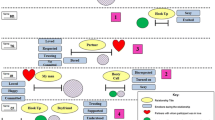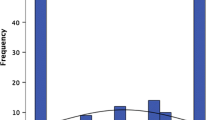Abstract
Roma (Gypsies), the largest and most disadvantaged ethnic minority group in Europe, are believed to be vulnerable to HIV/AIDS. This study’s aim was to examine HIV risk in 6 Roma male sociocentric networks (n = 405 men) in Bulgaria. Participants were interviewed concerning their risk practices and tested for HIV/STDs. High-risk sexual behaviors were common. Over 57% of men had multiple sexual partners in the past 3 months. Over one-third of men reported both male and female partners in the past year. Condom use was low. Greater levels of sexual risk were associated with lower intentions and self-efficacy for using condoms, drug use, having male partners, knowing HIV-positive persons, and having higher AIDS knowledge but no prior HIV testing. Two men had HIV infection, 3.7% gonorrhea, and 5.2% chlamydia. HIV prevention interventions directed toward high-risk social networks of Roma are needed before HIV infection becomes more widely established.

Similar content being viewed by others
References
Hajioff S, McKee M. The health of the Roma people: a review of the published literature. J Epidemiol Commun Health. 2000;54:864–9.
UNDP-Romania. Social assessment of Roma and HIV/AIDS in Central and Eastern Europe. Bucharest, Romania: United National Development Program/Romania Country Office and Center for Health Policies and Services; 2003.
World Bank. Roma and the transition in Central and Eastern Europe: trends and challenges. Washington, D.C.: World Bank; 2000.
Kelly JA, Amirkhanian YA. The newest epidemic: a review of HIV/AIDS in Central and Eastern Europe. Int J STD AIDS. 2003;14:361–71.
Bulgarian National AIDS Program. Brief current information on HIV/AIDS distribution in Bulgaria. Sofia, Bulgaria: Ministry of Public Health; 2011. Available at http://www.aidsprogram.bg/static_info1.php?
Liégeois J-P. Roma, gypsies, and travelers. Strasbourg, France: Council of Europe; 1994.
Puporka L, Zádori Z. The health status of Romas in Hungary. Budapest, Hungary: Roma Press Centre; 1998. Available at http://www.worldbank.org/eca/roma/data/romang.htm.
Barany Z. The socio-economic impact of regime change in eastern Europe: Gypsy marginality in the 1990s. East Eur Polit Soc. 2000;15:64–113.
European Forum for Democracy and Solidarity. Roma in Plovdiv. 01 Dec; 2002. Available at http://www.europeanforum.net/news/18.
National Statistical Institute. Health state of the population: census 2001. Sample studies Vol. 6, Book 4. Sofia, Bulgaria: National Statistical Institute; 2001.
Kelly JA, Amirkhanian YA, Kabakchieva E, Csepe P, Seal DW, Antonova R, Mihaylov A, Gyukits G. Gender roles and HIV sexual risk vulnerability of Roma (Gypsy) men and women in Bulgaria and Hungary: an ethnographic study. AIDS Care. 2004;16:231–45.
Kabakchieva E, Amirkhanian YA, Kelly JA, McAuliffe TL, Vassileva S. High levels of sexual HIV/STD risk behavior among Roma (Gypsy) men in Bulgaria: Patterns and predictors of risk in a representative community sample. Int J STD AIDS. 2002;13:184–91.
Amirkhanian YA, Kelly JA, McAuliffe TL. Identifying, recruiting, and assessing social networks at high risk for HIV/AIDS: methodology, practice, and a case study in St. Petersburg, Russia. AIDS Care. 2005;17:58–75.
Kabakchieva E, Vassileva S, Kelly JA, Amirkhanian YA, DiFranceisco WJ, McAuliffe TL, Antonova R, Mihaylova M, Vassilev B, Khouesine RA, Petrova E. HIV risk behavior patterns, predictors, and sexually transmitted disease prevalence in the social networks of young Roma (Gypsy) men in Sofia, Bulgaria. Sex Trans Dis. 2006;33:485–90.
Latkin CA, Sherman S, Knowlton AR. HIV Prevention among drug users: outcome of a network-oriented peer outreach intervention. Health Psychol. 2003;22:332–9.
Rothenberg R, Kimbrough L, Lewis-Hardy R, Heath B, Williams OC, Tambe P, Johnson D, Schrader M. Social network methods for endemic foci of syphilis: a pilot project. Sex Trans Dis. 2000;27:12–8.
Broadhead RS, Heckathorn DD, Weakliem DL, Anthony DL, Madray H, Mills RJ, Hughes J. Harnessing peer networks as an instrument for AIDS prevention: results from a peer-driven intervention. Public Health Rep. 1998;113(Supplement 1):42–57.
Róna-Tas A. Ustoychivost’ sotsial’nykh setey v postkommunisticheskoy transformatsii Vostochnoy Evropy [Sustainability of the social networks in the Eastern European postcommunist transformation]. In: Shanin T, editor. Neformal’naya ekonomika. Rossiya i mir [Informal economy. Russia and the world]. Moscow, Russia: Logos; 1999. p. 396–411.
Wetherell C, Plakans A, Wellman B. Social networks, kinship and community in Eastern Europe. J Interdiscip Hist. 1994;24:639–63.
Kelly JA, Amirkhanian YA, Kabakchieva E, Vassileva S, McAuliffe TL, DiFraceisco WJ, Antonova R, Petrova E, Vassilev B, Khoursine RA, Dimitrov B. Prevention of HIV and sexually transmitted diseases in high-risk social networks of young Roma (Gypsy) men in Bulgaria: randomized controlled trial. Brit Med J. 2006;333:1098–101.
Amirkhanian YA, Kelly JA, Kabakchieva E, Kirsanova AV, Vassileva S, Takacs J, DiFranceisco WJ, McAuliffe TL, Khoursine RA, Mocsonaki L. A randomized social network HIV prevention trial with young men who have sex with men in Russia and Bulgaria. AIDS. 2005;19:1897–905.
ASSA-M. Reproductive behaviour, family planning, contraceptive usage (Empirical Sociological Survey). Sofia, Bulgaria: ASSA-M; 1996.
Gyarmathy VA, Ujhelyi E, Neaigus A. HIV and selected blood-borne and sexually transmitted infections in a predominantly Roma (Gypsy) neighbourhood in Budapest, Hungary: a rapid assessment. Cent Eur J Public Health. 2008;16:124–7.
Evans AR, Hart GJ, Mole R, Mercer CH, Parutis V, Gerry CJ, Imrie J, Burns FM. Central and East European migrant men who have sex with men in London: a comparison of recruitment methods. BMC Med Res Methodol. 2011;11:69.
Bandura A. Social foundation of thought and action: a social-cognitive theory. Englewood Cliffs, NJ: Prentice Hall; 1986.
Fishbein M, Ajzen I. Belief, attitude, intention, and behavior: an introduction to theory and research. Reading, MA: Addison Wesley; 1975.
Fisher JD, Fisher WA. Changing AIDS risk behavior. Psychol Bull. 1992;111:455–74.
Acknowledgments
This research was supported by grant R01-DA023854 from the National Institute on Drug Abuse and grants P30-MH52776 and R24-MH082471from the National Institute of Mental Health. The authors thank Ruzanna Aleksanyan, Kevin Brown, Vanya Pavlova, and Zina Popova for their assistance.
Author information
Authors and Affiliations
Corresponding author
Rights and permissions
About this article
Cite this article
Amirkhanian, Y.A., Kelly, J.A., Kabakchieva, E. et al. High-Risk Sexual Behavior, HIV/STD Prevalence, and Risk Predictors in the Social Networks of Young Roma (Gypsy) Men in Bulgaria. J Immigrant Minority Health 15, 172–181 (2013). https://doi.org/10.1007/s10903-012-9596-4
Published:
Issue Date:
DOI: https://doi.org/10.1007/s10903-012-9596-4




